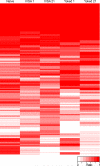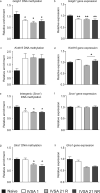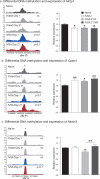Persistent variations in neuronal DNA methylation following cocaine self-administration and protracted abstinence in mice
- PMID: 27213137
- PMCID: PMC4874530
- DOI: 10.1016/j.nepig.2015.10.001
Persistent variations in neuronal DNA methylation following cocaine self-administration and protracted abstinence in mice
Abstract
Continued vulnerability to relapse during abstinence is characteristic of cocaine addiction and suggests that drug-induced neuroadaptations persist during abstinence. However, the precise cellular and molecular attributes of these adaptations remain equivocal. One possibility is that cocaine self-administration leads to enduring changes in DNA methylation. To address this possibility, we isolated neurons from medial prefrontal cortex and performed high throughput DNA sequencing to examine changes in DNA methylation following cocaine self-administration. Twenty-nine genomic regions became persistently differentially methylated during cocaine self-administration, and an additional 28 regions became selectively differentially methylated during abstinence. Altered DNA methylation was associated with isoform-specific changes in the expression of co-localizing genes. These results provide the first neuron-specific, genome-wide profile of changes in DNA methylation induced by cocaine self-administration and protracted abstinence. Moreover, our findings suggest that altered DNA methylation facilitates long-term behavioral adaptation in a manner that extends beyond the perpetuation of altered transcriptional states.
Keywords: DNA methylation; MBD; cocaine self-administration; genome-wide; neuron; next-generation sequencing; relapse.
Figures





References
-
- Arias-Vasquez A, Altink ME, Rommelse NN, Slaats-Willemse DI, Buschgens CJ, Fliers EA, Faraone SV, Sergeant JA, Oosterlaan J, Franke B, Buitelaar JK. CDH13 is associated with working memory performance in attention deficit/hyperactivity disorder. Genes Brain Behav. 2011;10:844–851. - PubMed
-
- Baker-Andresen D, Ratnu VS, Bredy TW. Dynamic DNA methylation: a prime candidate for genomic metaplasticity and behavioral adaptation. Trends Neurosci. 2012;36:3–13. - PubMed
-
- Barros M, Dempster EL, Illott N, Chabrawi S, Maior RS, Tomaz C, De Souza Silva MA, Huston JP, Mill J, Muller CP. Decreased methylation of the NK3 receptor coding gene (TACR3) after cocaine-induced place preference in marmoset monkeys. Addict. Biol. 2011;18:452–454. - PubMed
-
- Brown RM, Short JL, Cowen MS, Ledent C, Lawrence AJ. A differential role for the adenosine A2A receptor in opiate reinforcement vs opiate-seeking behavior. Neuropsychopharm. 2009;34:844–856. - PubMed
Grants and funding
LinkOut - more resources
Full Text Sources
Other Literature Sources
